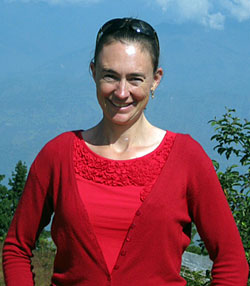Earthscope scientist leads SIT Nepal program
April 6th, 2018 | SIT Study Abroad

Beth Pratt-Sitaula, academic director for SIT Study Abroad’s Nepal: Geoscience in the Himalaya program, is a busy scientist. During the academic year, she directs the Cascadia EarthScope Earthquake and Tsunami Education Program. Recently, Beth also became a participant in two newly funded National Science Foundation grants and is assessment coordinator for geohazard workshops for Alaskan educators and Native American students. She is also part of the current EarthScope Speaker Series.
“EarthScope,” Beth explains, “is a decade-and-a-half-long geophysics initiative funded by the National Science Foundation. Some people have likened it to a Hubble telescope pointed at the ground. It allows us, with thousands of instruments, to understand the crust of North America and earthquake and volcanic hazards. These instruments can go to millimeters of accuracy. They can tell us things like how one side of the Sierra Nevada mountain range is different from the middle versus east, or versus the coast.”
The data help scientists understand and predict hazards and also aid efforts to understand the effects of climate change and water use. As a speaker for EarthScope, Beth joins a roster of speakers visiting colleges and universities to present the results of the project’s research so far.
And every summer, Beth joins SIT to help students learn geoscience in the unique and beautiful environs of the Himalaya. Theirs is not a distanced look at the science. “In earth and environmental sciences, field work has been considered fundamentally important. You can’t understand earth processes if you don’t go look at them!”
In Nepal, Beth guides students in the basics of understanding the geology around them. But, as with many SIT programs, SIT Nepal looks beyond the science. “The difference, the real value of our program,” Beth says, “is our emphasis on human-earth systems interactions. We look at ways to be wiser about living on the earth. Our students usually have a strong interest in earth sciences, but they are also interested in considering the human side of geoscience and why we need to know these things to make better societal decisions about geology and hazards.”
SIT students also get a chance to understand the Nepali view by meeting and working with local students. “For every 10 US students, there are usually four from Nepal. They complement each other’s skills, and the Nepali students serve as ambassadors and translators when they’re in the hills on expeditions.”
Thanks to SIT’s connections to the community and commitment to cross-cultural experience, she says, students have “the chance to hike areas tourists never, ever go.”
SIT Nepal emphasizes the human side of geology—not only what risks exist, but the decision-making and politics of risk mitigation and how things like flooding and hydropower affect communities. Nepal, Beth says, is one of the best possible places to study these issues. “You’re in the Himalayas—the processes and scale, the size and the speed at which things happen, are unparalleled anywhere else in the world.”
Her students learn about the issues firsthand by talking with Nepalis. Beth offers the example of students who, 15 months after the 2015 earthquake in Nepal, interviewed (with a translator) local residents about how groundwater springs—the main water source for much of the population—were affected by the earthquake. They found, she says, that many sprang open and gushed, but others went dry. Some went dry, but later reopened.
“They did a very nuanced and thoughtful analysis of how the springs behaved in two different areas,” Beth explains. Their data proved useful, and a German scientist was able to use it to advance his work. “The students did really worthwhile geoscience data collection.”
